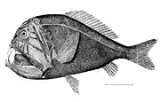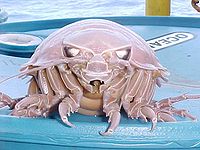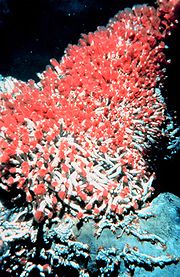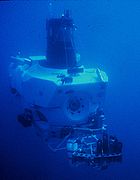
Deep sea creature
Encyclopedia

Photic zone
The photic zone or euphotic zone is the depth of the water in a lake or ocean that is exposed to sufficient sunlight for photosynthesis to occur...
of the ocean. These creatures must survive in extremely harsh conditions, such as hundreds of atmospheres of pressure, small amounts of oxygen, very little food, no sunlight, and constant, extreme cold. Most creatures have to depend on food floating down
Marine snow
In the deep ocean, marine snow is a continuous shower of mostly organic detritus falling from the upper layers of the water column. It is a significant means of exporting energy from the light-rich photic zone to the aphotic zone below. The term was first coined by the explorer William Beebe as he...
from above.
These creatures live in very harsh environments such as the abyssal
Abyssal zone
The abyssal zone is the abyssopelagic layer or pelagic zone that contains the very deep benthic communities near the bottom of oceans. "Abyss" derives from the Greek word ἄβυσσος, meaning bottomless. At depths of 4,000 to 6,000 metres , this zone remains in perpetual darkness and never receives...
or hadal
Hadal zone
The hadal zone , also known as the hadopelagic zone and trench zone, is the delineation for the deepest trenches in the ocean...
zones, which, being thousands of meters below the surface, are almost completely devoid of light. The water is very cold (between 3 and 10 degrees Celsius, or 37 and 50 degrees Fahrenheit), and has low oxygen levels. Due to the depth, the pressure is between 20 and 1,000 atmospheres
Atmosphères
Atmosphères is a piece for full orchestra, composed by György Ligeti in 1961. It is noted for eschewing conventional melody and metre in favor of dense sound textures...
. Creatures that live thousands of feet deep in the ocean have adapted to the high pressure, lack of light, and other factors.
Barometric pressure
These animals have evolvedNatural selection
Natural selection is the nonrandom process by which biologic traits become either more or less common in a population as a function of differential reproduction of their bearers. It is a key mechanism of evolution....
to survive the extreme pressure of the sub-photic zone
Photic zone
The photic zone or euphotic zone is the depth of the water in a lake or ocean that is exposed to sufficient sunlight for photosynthesis to occur...
s. The pressure increases by about one atmosphere every ten meters. To cope with the pressure, many fish are rather small, usually not exceeding 25 cm in length. Also, scientists have discovered that the deeper these creatures live, the more gelatinous their flesh and more minimal their skeletal structure. These creatures have also eliminated all excess cavities that would collapse under the pressure, such as swim bladders.
Lack of light
The lack of light requires creatures to have special adaptations to find food, avoid predators, and find mates. Most animals have very large eyes with retinas constructed only of cones, which increases sensitivity. Many animals have also developed large feelers to replace peripheral vision. To be able to reproduce, many of these fish have evolved to be hermaphroditic, eliminating the need to find a mate. Many creatures have also developed very strong senses of smell to detect the chemicals released by mates.Lack of Resources

Chemosynthesis
In biochemistry, chemosynthesis is the biological conversion of one or more carbon molecules and nutrients into organic matter using the oxidation of inorganic molecules or methane as a source of energy, rather than sunlight, as in photosynthesis...
(the process of changing chemical energy into food energy). Because of the sparse distributions of creatures, there is always at least some oxygen and food. Also, instead of using energy to search for food, these creatures use particular adaptations to ambush prey.
Hypoxic environment
Creatures that live in the sub-abyss require adaptations to cope with the naturally low oxygen levels.Deep-sea gigantism

Deep-sea gigantism
In zoology, deep-sea gigantism, also known as abyssal gigantism, is the tendency for species of crustaceans, invertebrates and other deep-sea-dwelling animals to display a larger size than their shallow-water counterparts...
describes an effect that living at such depths has on some creatures' sizes, especially relative to the size of relatives that live in different environments. These creatures are generally many times bigger than their smaller counterparts. The Giant Isopod
Giant isopod
A giant isopod is any of approximately nine species of large isopods in the genus Bathynomus. They are thought to be abundant in cold, deep waters of the Atlantic...
(related to the common pill bug) exemplifies this. Scientists haven't been able to explain deep-sea gigantism, with the exception of the giant tube worm
Giant tube worm
Giant tube worms, Riftia pachyptila, are marine invertebrates in the phylum Annelida related to tube worms commonly found in the intertidal and pelagic zones...
. Scientists believe these creatures are much larger than shallower-water tube worms because they live on hydrothermal vents that expel huge amounts of resources. They believe that, since the creatures don't have to expend energy regulating body temperature and have a smaller need for activity, they can allocate more resources to bodily processes.
There are also cases of deep-sea creatures being abnormally small, such as the lantern shark, which fits in an adult human
Human
Humans are the only living species in the Homo genus...
's palm.
Bioluminescence

Bioluminescence
Bioluminescence is the production and emission of light by a living organism. Its name is a hybrid word, originating from the Greek bios for "living" and the Latin lumen "light". Bioluminescence is a naturally occurring form of chemiluminescence where energy is released by a chemical reaction in...
is the ability for an organism to create light through chemical reactions. Creatures use bioluminescence in many ways: to light their way, attract prey, or seduce a mate. Many underwater animals are bioluminescent—from the Viper fish to the Flashlight fish
Flashlight fish
The flashlight fish are a family, the Anomalopidae, of beryciform fish. There are some unrelated fish with similar features, some of which are also called flashlight fish. Notable among these are the deep sea lanternfish, of the family Myctophidae, of which there are over 200 species.Flashlight...
, which is named for its light. Some creatures, such as the angler fish have a concentration of photophores in a small limb that protrudes from their bodies, which they use as a lure to catch curious fish. Bioluminescence can also confuse enemies. The chemical process of bioluminescence requires at least two chemicals: the light producing chemical called luciferin and the reaction causing chemical called luciferase. The luciferase catalyzes the oxidation of the luciferin causing light and resulting in an inactive oxyluciferin. Fresh luciferin must be brought in through the diet or through internal synthesis.
Chemosynthesis
Since at such deep levels, there is little to no sunlight, photosynthesisPhotosynthesis
Photosynthesis is a chemical process that converts carbon dioxide into organic compounds, especially sugars, using the energy from sunlight. Photosynthesis occurs in plants, algae, and many species of bacteria, but not in archaea. Photosynthetic organisms are called photoautotrophs, since they can...
is impossible as a means of energy production, leaving some creatures with the quandary of how to produce food for themselves. For the giant tube worm
Giant tube worm
Giant tube worms, Riftia pachyptila, are marine invertebrates in the phylum Annelida related to tube worms commonly found in the intertidal and pelagic zones...
, this answer comes in the form of bacteria that live inside of it. These bacteria are capable of chemosynthesis and live inside of the giant tube worm, which lives on hydrothermal vent
Hydrothermal vent
A hydrothermal vent is a fissure in a planet's surface from which geothermally heated water issues. Hydrothermal vents are commonly found near volcanically active places, areas where tectonic plates are moving apart, ocean basins, and hotspots. Hydrothermal vents exist because the earth is both...
s. These vents spew very high amounts of chemicals that these bacteria can transform into energy. These bacteria can also grow freely of a host and create mats of bacteria on the sea floor around hydrothermal vents, where they serve as food to other creatures. Bacteria are a key energy source in the food chain. This source of energy creates large populations in areas around hydrothermal vents, which provides scientists an easy stop for research.
Deep Sea Research

DSV Alvin
Alvin is a manned deep-ocean research submersible owned by the United States Navy and operated by the Woods Hole Oceanographic Institution in Woods Hole, Massachusetts. The vehicle was built by General Mills' Electronics Group in the same factory used to manufacture breakfast cereal-producing...
—owned by the US Navy and operated by the Woods Hole Oceanographic Institution
Woods Hole Oceanographic Institution
The Woods Hole Oceanographic Institution is a private, nonprofit research and higher education facility dedicated to the study of all aspects of marine science and engineering and to the education of marine researchers. Established in 1930, it is the largest independent oceanographic research...
(WHOI) in Woods Hole, Massachusetts
Woods Hole, Massachusetts
Woods Hole is a census-designated place in the town of Falmouth in Barnstable County, Massachusetts, United States. It lies at the extreme southwest corner of Cape Cod, near Martha's Vineyard and the Elizabeth Islands...
—exemplifies the type of craft used to explore deep water. This 16 ton submarine can withstand extreme pressure and is easily maneuverable despite its weight and size.
However, studying deep sea creatures is problematic, since with the extreme change in pressure, and environment in general, these creatures can't survive for very long, if at all, on the surface. This makes in depth research difficult because so much of what we want to know about only occurs while the creature is alive. Recent developments have allowed scientists to look at these creatures more closely, and for a longer time. A marine biologist, Jeffery Drazen, has explored a solution, a pressurized fish trap. This captures a deep-water creature, and adjusts its internal pressure slowly to surface level as the creature is brought to the surface, in hopes that the creature can adjust.
Another scientific team, from the Universite Pierre et Marie Curie, has developed a capture device known as the PERISCOP
PERISCOP
The PERISCOP is a pressurized recovery device designed for retrieving deep-sea marine life at depths exceeding 2,000 metres. The device was designed by Bruce Shillito and Gerard Hamel at the Universite Pierre et Marie Curie...
that maintains water pressure as it surfaces, keeping the samples in a pressurized environment during the ascent. This allows for close study on the surface without disturbances in pressure to the sample.
Deep Sea Creatures In Popular Culture
The BBCBBC
The British Broadcasting Corporation is a British public service broadcaster. Its headquarters is at Broadcasting House in the City of Westminster, London. It is the largest broadcaster in the world, with about 23,000 staff...
's Blue Planet
The Blue Planet
The Blue Planet is a BBC nature documentary series narrated by David Attenborough, first transmitted in the UK from 12 September 2001.Described as "the first ever comprehensive series on the natural history of the world's oceans", each of the eight 50-minute episodes examines a different aspect of...
have featured deep sea creatures, highlighting their peculiar attributes.
External links
- Deep Ocean Diversity Slideshow - Smithsonian Ocean Portal
- Sea and Sky: Monsters of the Deep Sea - Details about specific creatures
- Marine Biology: The Deep Sea - General resource on deep sea creatures
- Monterey Bay Aquarium: Online Field Guide - Details about specific creatures
- The Bioluminescence Web Page - Good resource on bioluminescence
- NeMO Explorer - Good resource on chemosynthesis
- Deep Sea Monsters - Good resource on different kinds of deep sea fishes
- Undersea Wonders - slideshow by Life magazine

